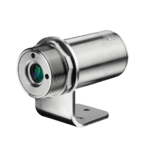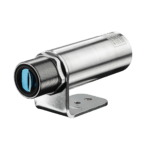Black Body
A black body is an idealized body that fully absorbs impinging electromagnetic radiation of any wavelength. Neither reflection nor transmission occur on it.
A black body radiates at every wavelength the maximum possible energy for all possible emitters. The radiation density is independent of angles here. The black body forms the basis for understanding the physical principles of non-contact temperature measurement technology and for calibrating absorbs devices.
Radiation Laws of the Black Body
Planck’s Law of Radiation describes the spectral specific radiation Mλs of the black body into the half-space as a function of its temperature T and the observed wavelength λ. It thus represents the most basic relationship for non-contact temperature measurement.
The maximum of the spectral specific radiation shifts with increasing temperature to shorter wavelengths. A variety of other relationships can be derived, two of which are briefly named below.
By integrating the spectral radiation intensity over all wavelengths from zero to infinity, one obtains the value for the total radiation emitted by the body. This relationship is referred to as the → Stefan Boltzmann Law.
MλS = σ · T4 [W · m-2] mit σ = 5,67 · 10-8 [Wm-2T-4]
The total emitted radiation of a black body in the entire wavelength range increases in proportion to the fourth power of its absolute temperature.
It can be seen from the graphical representation of Planck’s Law of Radiation that the wavelength at which the emitted radiation of a black body emits the maximum shifts as the temperature changes. → Wien’s Displacement Law describes this connection and can be derived by differentiation from Planck’s equation. The wavelength at which the maximum of the radiation is located shifts with increasing temperature to the short-wave range.
λmax · T = 2898 µm · K
Structure of the Black Body
The construction of a black body is in principle very simple. A heatable hollow body has a small hole at one end. If this body is brought to a certain temperature, this cavity is in temperature equilibrium. The ideal black radiation of the set temperature now emerges from the hole. Depending on the temperature range and intended use, the structure of such black bodies depends both on the material and on the geometric structure. For example, if the hole in the wall is very small compared to the entire surface, the disturbance of the ideal state may be considered as low. If one only looks at this hole with a sensor, the exiting temperature radiation can be regarded as a black body and the measuring device can be calibrated with it.
Recommended Device
Share article
Contact for Advice and Sales Worldwide
We offer comprehensive advice for your individual applications
Our experienced application engineers ensure competent and reliable customer service in the field. In addition, Optris works closely with numerous distribution partners worldwide.
USA and Canada
Optris Infrared Sensing LLC
Portsmouth, NH 03801 USA
Tel: +1 603 766-6060
E-Mail: sales@optris-ir.com
Internet: www.optris.com
Managing Director:
Paul Czerepuszko




